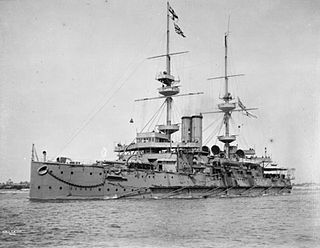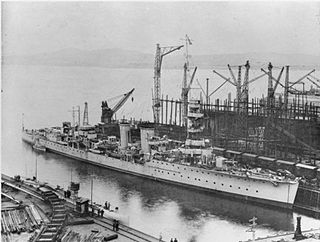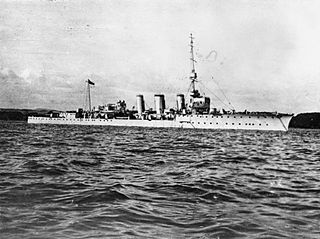
HMS Caesar was a Majestic-class pre-dreadnought battleship of the Royal Navy, named after the Roman military and political leader Julius Caesar. The ship was built at the Portsmouth Dockyard, starting with her keel laying in March 1895. She was launched in September 1896 and was commissioned into the fleet in January 1898. She was armed with a main battery of four 12-inch (305 mm) guns and a secondary battery of twelve 6-inch (152 mm) guns. The ship had a top speed of 16 knots.

HMS Cardiff was a C-class light cruiser built for the Royal Navy during World War I. She was one of the five ships of the Ceres sub-class and spent most of her career as a flagship. Assigned to the Grand Fleet during the war, the ship participated in the Second Battle of Heligoland Bight in late 1917. Cardiff was briefly deployed to the Baltic in late 1918 supporting anti-Bolshevik forces during the British campaign in the Baltic during the Russian Civil War.

HMAS Brisbane was a Town class light cruiser of the Royal Australian Navy (RAN). Built in Sydney between 1913 and 1916 to the Chatham subtype design, Brisbane operated in the Indian Ocean, Pacific Ocean, and Australian coastal waters during World War I.

HMS Castor was one of the Cambrian subclass of the C class of light cruisers. She saw service during the First World War and the Russian Civil War.

HMS Calliope was a C-class light cruiser of the Royal Navy under construction at the outbreak of the First World War. Both Calliope and her sister ship Champion were based on the earlier cruiser Caroline. They were effectively test ships for the use of geared turbines which resulted in the one less funnel. They also received slightly thicker armour. They led into the first of the Cambrian subclass.

The fourth HMS Comus was a C-class light cruiser of the Royal Navy that saw service in World War I. She was part of the Caroline group of the C class.

HMS Caroline is a decommissioned C-class light cruiser of the Royal Navy that saw combat service in the First World War and served as an administrative centre in the Second World War. Caroline was launched and commissioned in 1914. At the time of her decommissioning in 2011 she was the second-oldest ship in Royal Navy service, after HMS Victory. She served as a static headquarters and training ship for the Royal Naval Reserve, based in Alexandra Dock, Belfast, Northern Ireland, for the later stages of her career. She was converted into a museum ship. From October 2016 she underwent inspection and repairs to her hull at Harland and Wolff and opened to the public on 1 July 2017 at Alexandra Dock in the Titanic Quarter in Belfast.

HMS Commonwealth was a King Edward VII-class battleship of the British Royal Navy. Like all ships of the class she was named after an important part of the British Empire, namely the Commonwealth of Australia. Armed with a battery of four 12-inch (305 mm) and four 9.2 in (234 mm) guns, she and her sister ships marked a significant advance in offensive power compared to earlier British battleship designs that did not carry the 9.2 in guns. Commonwealth was built at the Fairfield Shipbuilding and Engineering Company, and was laid down in June 1902, launched in May 1903, and completed in March 1905.

HMS Diomede was a Danae-class cruiser of the Royal Navy. Constructed at Vickers Armstrong, Barrow, she was constructed too late to take part in World War I and was completed at the Royal Dockyard, Portsmouth. Between the wars, she served on the China Station, Pacific waters, East Indies Waters and from 1936 onwards, in reserve. In World War II she performed four years of arduous war duty, during which time she captured the crew of the German blockade runner Idarwald after she had chased that ship and when the crew scuttled Idarwald. Between 22 July 1942 and 24 September 1943 she was converted to a training ship at Rosyth Dockyard. In 1945 she was placed in reserve and scrapped a year later.

HMS Coventry was a C-class light cruiser of the Royal Navy, named after the English city of Coventry. She was part of the Ceres group of the C-class of cruisers.

HMS Caradoc was a C-class light cruiser built for the Royal Navy during World War I. She was one of the four ships of the Caledon sub-class. Assigned to the Grand Fleet during the war, the ship participated in the Second Battle of Heligoland Bight in late 1917. Caradoc was briefly deployed to the Baltic in late 1918 supporting anti-Bolshevik forces during the British campaign in the Baltic and then was transferred to the Mediterranean Fleet in early 1919 and spent the next year and a half doing the same thing in the Black Sea during the Russian Civil War. The ship was withdrawn from the Black Sea in mid-1920 to observe the Greco-Turkish War of 1919–22 and the Chanak Crisis of late 1922. Caradoc spent most of the rest of her time between the World Wars overseas or in reserve with deployments to the Far East and the North America and West Indies Station.

HMS Centaur was a C-class light cruiser of the Royal Navy that served in the First World War and the Russian Civil War. She was the name ship of the Centaur group of the C-class of cruisers.

HMS Cambrian was a C-class light cruiser built for the Royal Navy during World War I. She was the name ship of her sub-class of four ships. Assigned to the Grand Fleet upon completion in 1916, the ship played only a small role during the war. Cambrian was assigned to the Atlantic and Mediterranean Fleets during the 1920s and was sent to support British interests in Turkey during the Chanak Crisis of 1922–1923. The ship was placed in reserve in late 1929. She was sold for scrap in 1934.

HMS Canterbury was a C-class light cruiser of the Royal Navy that saw service in the First World War and the Russian Civil War. She was part of the Cambrian group of the C class.

HMS Constance was a C-class light cruiser of the Royal Navy that saw service in World War I. She was part of the Cambrian group of the C class.

HMS Champion was a C-class light cruiser of the Royal Navy that saw service during World War I. She was part of the Calliope group of the C class.

The fourth HMS Cleopatra was a C-class light cruiser of the Royal Navy that saw service during World War I and the Russian Civil War. She was part of the Caroline group of the C class.

HMS Carysfort was a C-class light cruiser built for the Royal Navy during World War I. She was one of six ships of the Caroline sub-class and was completed in 1915. Assigned to the Grand Fleet, the Harwich Force, and the Dover Patrol during the war, the ship served as a flagship for part of the war. Her only known combat was a short battle against German torpedo boats in the English Channel, although she was very active patrolling the North Sea and unsuccessfully searching for German ships. Carysfort was assigned to the Home and Atlantic Fleets after the war and was sent to the Mediterranean Fleet during the Chanak Crisis of 1922–23 to support British interests in Turkey. In 1922, she patrolled off the Irish coast during the Irish Civil War. The ship was placed in reserve after returning home in 1923 and, aside from ferrying troops overseas, remained in reserve until she was sold for scrap in 1931.

HMS Conquest was a C-class light cruiser of the Royal Navy that saw service during World War I. She was part of the Caroline group of the C class.

HMS Cordelia was a C-class light cruiser built for the Royal Navy during World War I. She was one of six ships of the Caroline sub-class and was completed at the beginning of 1915. The ship was assigned to the 1st and 4th Light Cruiser Squadrons (LCS) of the Grand Fleet for the entire war and played a minor role in the Battle of Jutland in mid-1916. Cordelia spent most of her time on uneventful patrols of the North Sea. She served as a training ship for most of 1919 before she was recommissioned for service with the Atlantic Fleet in 1920. The ship was placed in reserve at the end of 1922 and was sold for scrap in mid-1923.






















